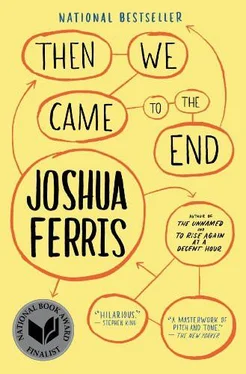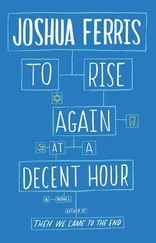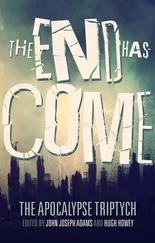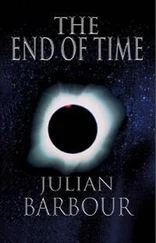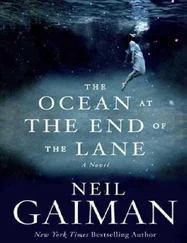We asked Marcia why she should be on eggshells. She looked around conspiratorially, unusual for her, because she typically didn’t give a damn who heard her say what. Marcia was never on eggshells. She was born and raised in Bridgeport, she changed her own oil, she listened to Mötley Crüe.
“Because I’m the one who took Tom Mota’s chair,” she confessed. “You understand? Tom’s chair is in my office. It’s always been the rule that when someone leaves, if you get in there first you can take their chair. I got in there first, I took Tom’s chair. I didn’t know anything about serial numbers. Not until that tool started jabber-assing about them yesterday at the input. Since then I’ve been on eggshells. It’s made me crazy. I want to get rid of it, but because he took Ernie’s chair down to Tom’s office, trying to pretend it was really Tom’s and not Ernie’s, I can’t take Tom’s real chair down there because then Tom would have two chairs. Isn’t that going to look suspicious? But if they look and see I have the chair with Tom’s serial numbers on it — don’t you see, I have the chair with the serial numbers! What should I do? Who knew about these serial numbers? I didn’t. Did you?”
She was as breathless and worked up as Yop himself. We told her to get ahold of herself. Chris Yop was not let go just because he was caught with Tom Mota’s buckshelves. He was let go because he can’t even draw up his own resume without filling it with typos. Lynn Mason and the other partners couldn’t trust million-dollar ad campaigns to sloppy copywriters — that is, if we ever had million-dollar ad campaigns again. That’s why Chris Yop was let go.
All the same, we thought it would be prudent of her to go into Tom’s office and swap Ernie’s chair with Tom’s. It was a delicate time, and in delicate times it made sense to take every precaution. Better to be caught with Ernie’s chair than with Tom’s. And just as we said that, we caught ourselves talking about such things as which chair Marcia would be better off being caught with, and we realized then how far we had fallen.
JOE SHOWED UP TO the double meeting carrying his day planner, which was predictable and annoying. We were irked by the steadfast familiarity of that goddamn day planner. Sometimes we almost thought we could like Joe if just one time out of ten he left that leather-bound diary behind at his desk. But no. The couch and the two loveseats and the leather recliners were all taken so Joe had to sit on the floor.
At a double meeting a couple things always happened. Joe split us up into teams, one art director for every copywriter. Ideally, after the double meeting, each team would get together and brainstorm ideas. How it worked in practice was always a little different, however. The copywriter went off on his own and the art director did the same, generating ideas independently of one another. Then they got together to battle it out. Who was wittier, who had more savvy, who had sailed it out of the park. We all had the same prayer: please let it be me. Regardless of who that me was, he or she tried to be very discreet about it, but there was no denying it, they reigned victorious for a day while the rest of us returned to our desks to chew silently on our own spines. We had lost, and our dimwittedness made us vulnerable to low opinion, whispered denigrations, and the dread prospect of being next.
So imagine our surprise, and our chagrin, when we sat down at the couches with our coffees to double meet — during which time we only refined details, we only requested clarifications — and Karen Woo announced that she already had ad concepts. She had an entire campaign. “You know what, I’m sick of seeing attractive sixtyish-type women smiling into the camera and saying, ‘Look at me, I’m a survivor. I defeated breast cancer.’ That’s bullshit,” she said. “This industry needs to cut through the happy-smiley clutter and get nasty with some truth.”
We looked at her with our chins floating in our coffee cups. Hold up! we wanted to shout. You can’t have concepts. We haven’t even double met yet!
“What’s your idea?” asked Joe.
Her idea? We’ll tell you her idea, Joe. To slaughter. Nobody talks about it, nobody says a word, but the real engine running the place is the primal desire to kill. To be the best ad person in the building, to inspire jealousy, to defeat all the rest. The threat of layoffs just made it a more efficient machine.
“It surprises me that you have concepts already, Karen,” said Larry Novotny. Karen and Larry didn’t get on so well. “It really surprises me.”
“Initiative,” Karen said smugly.
“I don’t want to speak for anybody else,” Larry added, “but to be honest, it really surprises the hell out of all of us.”
Karen leaned forward on the sofa and turned to Larry in his recliner, his eyes hard to see under the arced canopy of his Cubs cap. He was wearing one of his boring flannel shirts. They had a stare-down. Karen and Larry didn’t get on because Larry was an Art Director and Karen a Senior Art Director and titles meant everything. Every AD wanted to be a SAD. If you were a SAD you had your eyes on becoming an Acker. Acker was our phonetic translation of Associate Creative Director. Ackers wanted to be Creetors (Creative Directors), and every Creetor envied the Eveeps. You could either be a Creveep (Creative Executive Vice President) or an Ackveep (Account Services Executive Vice President), but both species hoped equally to be invited one day into partnership. What the partners dreamed of was the stuff of Magellan, da Gama, Columbus, et al.
The point was we took this shit very seriously. They had taken away our flowers, our summer days, and our bonuses, we were on a wage freeze and a hiring freeze, and people were flying out the door like so many dismantled dummies. We had one thing still going for us: the prospect of a promotion. A new title: true, it came with no money, the power was almost always illusory, the bestowal a cheap shrewd device concocted by management to keep us from mutiny, but when word circulated that one of us had jumped up an acronym, that person was just a little quieter that day, took a longer lunch than usual, came back with shopping bags, spent the afternoon speaking softly into the telephone, and left whenever they wanted that night, while the rest of us sent e-mails flying back and forth on the lofty topics of Injustice and Uncertainty.
“Karen,” said Joe. “What’s your idea?”
Karen broke off from Larry and turned to Joe.
“Take a look,” said Karen. She unveiled three polished concepts she called the “Loved Ones” campaign. From the stock houses she had secured close-ups of individual faces, all male. The first was a black boy, the second an Asian man, the last an older white gentleman. They looked directly at the camera without expression. We all thought, she’s been on Photonica’s website for the past eighteen hours looking for these gems. The headlines were an exercise in simplicity and the art of the tease. Each was a quote. With some work in Photoshop, Karen had the black boy holding a white placard that read, “My Aunt.” The Asian man’s placard said, “My Mother.” The old white guy’s said, “My Wife.” That was it, the images and the headlines. They were arresting enough, Karen believed, that anyone coming across them would be prompted to read the body copy, where a first-person testimonial explained the anguish of losing a loved one to breast cancer and the dire need for a cure.
“Bit of a downer,” suggested Larry, “don’t you think?”
“No, Larry. I don’t think. It’s gripping and honest and motivating, is what it is.”
“Not very palatable.”
“It is too palatable, Larry!”
Читать дальше
